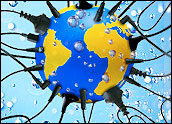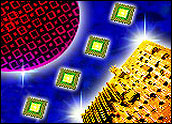
A combination of aging computers and their operating systems, alongwith reduced hardware prices, contributed to higher worldwide shipmentsfor the leading PC makers in the closing quarter of 2009, according to two industry reports.
Worldwide PC shipments increased 15.2 percent for last year’s fourthquarter over the same period in 2008, according to the IDC QuarterlyPC Tracker Report released Wednesday. Findings from research firm Gartner were even sunnier; it figured that global PC shipments grew some 22percent in the fourth quarter year over year.
The two firms use different tallying methods, resulting in a range ofgrowth. For instance, the U.S. PC market showed record sales of nearly20.7 million units shipped in the fourth quarter of 2009. Thisresulted in year-on-year growth of 24 percent, IDC reported. Bycomparison, U.S. PC shipments totaled 19.8 million units in the fourthquarter of 2009, establishing a 26.5 percent increase over theprevious fourth quarter, according to Gartner.
Both research firm’s reports showed that 2009 ended with the highestquarter over quarter growth rate in the U.S. in the last seven years.The bottom line is that the market appears to be recovering from very sluggish PCsales in previous quarters.
“All through the past year we’ve seen more variety of lower-cost PCs.There also has been pent-up demand from the bad economy,” Jay Chou,worldwide quarterly PC tracker research analyst for IDC, told TheE-Commerce Times.
Report Details
Both research firms credited similar higher global sales for the sametop five PC makers. One clear distinction between both reports is thatthe type of buyer made a difference. PC makers that cater more toa consumer base did better in the fourth quarter than PCmakers selling mostly to corporations, noted Gartner.
HP topped both lists as the No. 1 worldwide PC maker for the fourth quarter. That company sawglobal shipments increase over 24 percent, according to both IDC andGartner. HP displayed above-market performance in all but one region.Gartner ranked HP as No. 1 based on a 19.8 percent market shareworldwide.
China-based Acer’s PC sales grew to 13.5 market share worldwide, according to Gartner.
Dell was able to get back into positive territory after four quartersof year-over-year declines. The vendor managed overall growth of 5 percent,according to IDC. Dell faired almost evenly in Gartner’s report, with a5.7 percent overall sales growth as the No. 2 contender. Gartnerranked Dell as No. 3 in the top five computer makers with an11.5 percent market share.
Lenovo gained a market share of 9.2 percent, up from 7.5 percent,according to IDC. Gartner placed Lenovo in the No. 4 slot aswell, based on an 8.7 percent market share. Toshiba claimed the finalspot among the top five with a 5.6 per cent share of the PC market inthe fourth quarter, according to IDC, and 5.3 percent share based onGartner’s calculations.
Good Deals
A good part of the consumer sales growth for new PCs was the timing ofthe buying season. Manufacturers started seasonal promotions muchearlier, noted Chou.
“We saw an unprecedented level of marketing and a high degree ofdiscounts. A $500 PC or $300 netbook isn’t that much to spend on a newcomputer with a new operating system,” said Chou.
Strong consumer interest in netbooks was a very big part of PC makers’success in the fourth quarter, he added, Plus, people were tired ofthe aging Windows XP operating systems.
Indeed, the mobile computing craze was a contributing factor, noted aGartner researcher.
“Shipment growth was largely driven by low-priced consumer mobile PCs,both in regular notebooks and mini-notebooks. As economic weaknesscontinued, buyers became extremely price sensitive. Low-priced PCswere good enough for many average consumers,” said Mikako Kitagawa,principal analyst at Gartner.
OS Envy
The timing of Microsoft’s release of the Windows 7 operating systemwas also a part of the rush to buy a new computer. How much impactbuying a new PC for its new OS had on sales had, however, is up fordiscussion.
“Windows 7 was launched during the fourth quarter of 2009. Though thenew operating system launch did not create additional PC demand, thelaunch was a good market tool during holiday sales,” said Gartner’sKitagawa.
Windows 7 had much more of an impact, according to IDC’s Chou.Historically, he did not see the launch of a new PC as being toosignificant on PC sales.
“Interest in Windows 7 was a factor in the new PC sales,” Chou said.
Continued Trend
An example of the impact of the new OS can be seen in the success ofHP’s touchscreen notebooks. Windows 7 is going to change the computer touchscreen from a luxury item into a common PC feature,Chou predicted.
Netbooks and the emerging category of the ultra thin-notebook willcontinue to drive the PC sales market, said Chou.






















































Social Media
See all Social Media